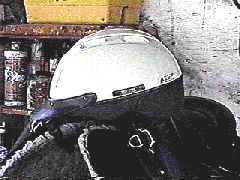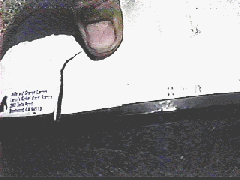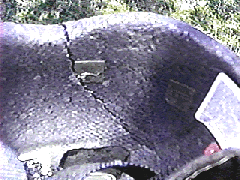What's Your Head Worth? - Real Events
Breaking your helmet and walking away from it...

Breaking your helmet and walking away from it...

Those of you who are fans of the TV series "Rescue 9-1-1" may recognize the name, Lana Fox. She was the lady who rescued an accident victim from a burning car on a highway near Rodeo, CA., when everyone else ran the other way.
Lana used to be our neighbor. I say "used to be" since her luck ran out one day when a green Arabian youngster she was mounting bolted and stuffed her head into a utility pole. The resulting injuries were fatal. In fact, as we discovered, around that time there had been at least a half dozen fatal equestrian accidents in the region centered by Contra Costa County, and several more which resulted in serious injuries. Many of these accidents included blunt trauma to the head from fixed objects and/or horse hooves.
In response to this gruesome trend, a number of us produced the "Equestrian Crash Course" and use of helmets in the area increased dramatically. Interestingly enough, fatal equestrian accidents correspondingly declined. Around the barn we have had the usual "unscheduled flights" from such expected activities as horses and riders falling at a gallop or blowing a jump, however on June 8th, 1997, we discovered potentially serious accidents can happen almost anywhere.
I had just finished giving a fairly green 14hh gelding a half hour workout and another rider hopped on to cool him out. They wandered over to the "tie area" where the rider was calmly sitting, chatting with another rider who she expected to join her. A rather boisterous filly was eating from a manger nearby, and although she was tied, she lunged at the little horse which she thought was getting too close. A timid sort around other horses, the gelding startled which in turn startled a third horse tied nearby. Although the rider tried to regain control, the little horse gave a few big league spinning bucks and the rider came off, landing on her head and shoulders hard enough to break the helmet.
Fortunately the helmet did its job and absorbed the impact. Although bruised and temporarily stunned, the rider checked out OK and resumed her activities around the stable.

This closeup shows the point of impact. The shell of this lightweight
Troxel EQ is designed primarily to protect the styrofoam liner, with the liner providing the major element of head protection. The ground
was hard enough to crack the shell under high impact.

This closeup shows the helmet lining. The impact to the head dissipated
through the lining, manifesting itself in this large crack. It is our
opinion that this damage is not suggestive of any failure of the helmet.
We believe the helmet absorbed and dissipated the impact as it should have,
as evidenced by a total lack of any blunt trauma injury to the rider's
head. At minimum, this helmet saved a trip to the emergency room.
The point of this report is not to express concern about the apparent damage to the helmet. It did its job. We'll mail it back to Troxel who will replace it for a $15.00 service charge. The interesting aspect here is that when one least expects it, sitting quietly on a tired horse, the unexpected can happen with violent results. Therefore the wearing of helmets is always appropriate, not just when working at speed or over jumps.
For those of you who have linked over here from the Wild Horse and Burro Page, unseasoned horses, whether feral or domestic, can behave unpredictably when one least expects it. While this may not be cause for alarm, it is reason enough to be properly prepared and properly equipped; with a properly fitting saddle, good headstall and reins with an appropriate size bit for the horse's mouth, boots with heels which won't get hung up in the stirrups and, of course, head protection. In addition to having the right equipment, it should be regularly inspected and maintained. In this manner you can meet the challenge and have an exciting and rewarding time with your equine subject.
Dear KBR (Willis & Sharon)
I just finished reading the article, "What's Your Head Worth".
I spent today getting a cat-scan after tripping, falling and striking my head on a workbench at my home. The accident occured 11-4-97. I am still suffering from headaches. The reason I mention all of this is simple, If I can get a serious injury in my own home, doesn't it make sense to wear a helmet when engaging in a potentially dangerous activity such as horseback riding?
My horses are of the "bomb-proof" variety, yet things happen. Please keep up the campaign to encourage using helmets at ALL times horses are involved.
I look forward to healing and working with my horses again. Rest assured, I will have a helmet on.
Thanks, Teresa, for the really relevant comments! Here's hoping you get back on your feet and horses soon!
The URL for information is http://4h.wsu.edu/videter.html. For further information you can contact the foundation at 253-445-4570.